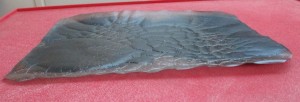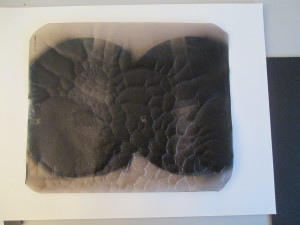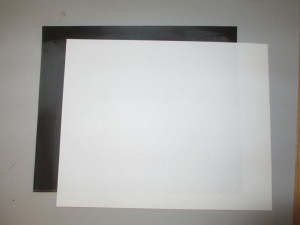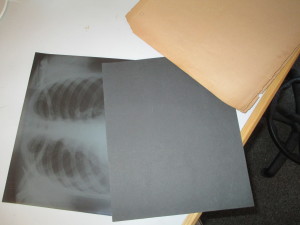The radiographs make up a significant part of the Stannington collection with a total of 14,674 separate images relating to 2220 different patients covering roughly a 20 year period from 1936 to c.1955. When the records were recovered in the 1980s the vast majority of the radiographs were copied on to microfiche and the originals destroyed as they were unstable. However, we still have 326 original radiographs within the collection. Over the course of the project all the microfiche images and the originals will be digitised and made publicly accessible. We also hope to preserve the remaining original radiographs as examples of how x-ray images at the time were produced. The problem here lies with the unstable nature of the film and its natural degradation.
All the radiographs were produced on cellulose acetate film, known as safety film as it replaced the earlier nitrate film that was highly flammable and potentially self-combustible, a problem for many film archives today. Over time the cellulose acetate film naturally breaks down, the early stages of this are recognisable by the strong smell of vinegar coming off the film as the process gives off acetic acid and because of this is known as vinegar syndrome. Eventually as the base of the film and the top layer pull away from one another the film will begin to buckle and crack and bubbles can form under the surface.


This process is already evident in several of the radiographs we hold (figures 1 & 2) and unfortunately there isn’t anything that can be done to reverse or halt the process. By storing the films in a closely monitored temperature and humidity controlled environment we hope to delay the process in most of the radiographs for as long as possible.


The x-rays were originally stored in ordinary brown envelopes and there could be as many as 15 in each envelope. (Figure 3) To help preserve them we have instead transferred each x-ray into an individual acid free sleeve. (Figure 4) By storing them individually we are able to minimise any accumulation of acetic acid that is produced in the degradation process. Thanks to advice from conservators at Durham County Record Office and their assistance in sourcing the new x-ray envelopes, all the original films are now safely stored in their own envelopes in our photogrpahic strong room.
This degradation is evident in some of the microfiche as well as the original films had obviously started to buckle already at the time they were transferred to microfiche in the 1980s. Consequently some of the images are obscured by a crackling effect. Nevertheless the vast majority of the 14,674 images remain easily readable and the digitisation process will mean that they remain clearly accessible for future use.
[See our Flickr stream for examples of some of the radiographs https://www.flickr.com/photos/99322319@N07/sets/72157648833066476/]
